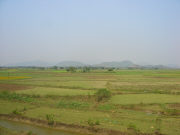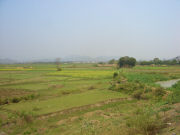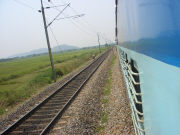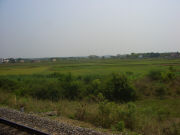
|
You are on the page: Home page ➤ Photo galleries of India ➤ Odisha (Orissa)
|
 |
 |
20000 photos of India, 1280х960
Odisha (Orissa) photos
|
The ancient kingdom of Kalinga, which was invaded by the Mauryan emperor Ashoka in 261 BCE resulting in the bloody Kalinga War, coincides with the modern day Odisha. The name of the state was changed from Orissa to Odisha and its language from Oriya to Odia in 2011. KonarkBhubaneshvar Puri 


 Orissa is Kalinga country of Mahabharat. It was the bloodbath in 261 BCE here that Emperor Ashoka saw in his conquest of Kalinga that brought about his conversion into Buddhism. Then came King Kharavela, a great conqueror, and patron of Jainism. Orissa’s legacy of numerous Buddhist and Jain monuments can be traced back to these influences. The name of the state comes from the ethnonym "Oriya" — the main population of this state. According to the 2001 census, the population of Orissa is 36 706 920 people; 50.89% are men, 49.11% are women. The population density is 236 people/km2. The rural population is 85.01%, the urban population is 14.99%. The main ethnic group of the region is Oriya. 83.2% of the population speaks the Oriya language; 2.8% — Hindi; 2.5% — Kui; 2,5% — Santali; 1.9% — Telugu; 1,7% — Urdu; 1,3% — Bengali. There are also people who speak various Austroasiatic and Dravidian languages, common in the region, but their proportion is insignificant. Oriya is an Indo-European language spoken by about 35 million people in the Indian state of Orissa. He is one of the 23 officially recognized languages of India and has his own alphabet. Oriya belongs to the group of new Indian languages. Territory of distribution: Indian state of Orissa and some districts of the adjoining states. The writing of the Oriya language goes back to the writing of Brahmi and is quite different from any other Indian language. The oldest literary monuments date back to the 13th century. One of them is the version of "Mahabharata" made by Sarala Das. Modern literary language begins with the period of writings of Fakir Mohan Senapati. Orissa youth in Bhubaneswar often know English very well, perhaps because of the uniqueness of the local Oriya language that Indians from other states do not understand. Hinduism is followed by 94.4% of the population, Christianity — 2.4%, Islam — 2.1%, other religions — 1.1%. The literacy rate is 63.61% of the population; 75.95% of men and 50.97% of women. According to data for 2000, more than 47% of the population lives below the poverty line, which is much higher than the average Indian index. |
|
Bhubaneshwar, the capital city, is also the temple-city, has more than 500 temples. The most important ones are the 54 meters high Lingaraj Temple, Mukteswar temple with its famous entrance arch and Parasurameswara Temple with its latticed windows. Tourist spots for historical sites are Boudh with a large statue of the Buddha; Ashoka's rock edict at Dhauli; Ranipur with its Ranipur-Jharial's temples dedicated to 64 yoginis; ruins of a Buddhist complex at Ratnagiri-Lalitgiri-Udayagiri where a Buddhist University called Pushpagiri flourished; rock-cut caves with ornate carvings at Khandagiri-Udayagiri; and 13th century Sun Temple on the beach at Konarka, an architectural marvel built on rock in the shape of a chariot drawn by seven horses. Religious sites of the Odisha are the world renowned Jagannath temple of Puri, temples of Balangir, Baripada, Kantilo, Viraja, and Sveta Varaha temples of Jajapur, and the hilltop Shiva Temple (Chandrashekhar Temple) at Kapilash at a height of about 2239 feet from sea level with 1352 steps and the other way is thru Barabanki or travelling by the twisting way. Interesting places of nature are hot sulphur springs at Taptapani and Atri, Chilika, the largest coastal lagoon in India and the second largest coastal lagoon in the world; Deogarh waterfalls in Pradhanpet; Gopalpur, an ancient port and beach resort. Hirakud dam site; Phulabani, centre of the tribal belt, Chandipur beach and Hill station of Kendujhar (Kendujhargarh), 480 meters above sea level. Wildlife sanctuaries and national parks are Simlipal, Tikarpara, Ushakothi and Nandankanan Zoological Park, home to the country’s largest lion safari and the only white tiger reserve; Paradwip — a major port, Rourkela — major steel plant. There was one interesting real story with the Jagannatha temple with the author of this article. When I first came to the temple complex of Sri Rangam in Tamil Nadu in February 2004, on the 4th perimeter of the gopurams (there are 7 of them, these are trapezoidal arches), the guards braked me — "only Hindu!" And I went to administrator of the temple, in a 10-minute conversation pushing, among other facts, that Hinduism is a belief, and not racism based on skin color, and persuading him to let me go inside the temple after telling various Hindu religious legends. After the special darshan (a couple of meters closer to the main murti) for the then 10 rupees, near the altar I have met the white-skinned ISKCON member in the Vaishnava "unionalls" and have asked him in English: "Did you also went through a conversation with the temple administrator?" And he proudly said: "No, in this [Vaishnava] garment I can freely go into any temple in India!" "Really, and in Jagannath Puri also?" ;) In one second he became noticeably sad, but then exclaimed with strained enthusiasm: "But you can get the same benefit from darsana (contemplation) of the chakra (disc) on the top of the Jagannath temple! So my mentors said." It was clear that even he himself does not believe in this nonsense (for white-skinned), and in response to my eloquent glance (I did not believe in this for sure :) he was embarrassed finally. Gradually, we talked, it turned out that his name is Paramdhan (his name in ISKCON), he is from Karlovy Vary (Czech Republic), but he lives in England for the last few years. After some talking each went his own way. I went to visit other temples of Tamil Nadu. Three months later, in mid-May, I came to Badrinath, and on the first day I meet Paramdhan! He recognized me, and his first words were not even "Hello", but "I went inside to the murti in the temple of Jagannath!!!" "How?" "In the hotel I smeared myself with black cream, wrapped all over in simple Indian clothes, leaving bare face only, and sided in front of the temple to a group of village Indian pilgrims, and went inside with them." "Do you know that in such an attempt, just before the altar of temple of Jagannatha in 1994, was killed one African-American, supposedly even a disciple of Prabhupada? He too was wrapped all over in clothes, but he was noticed by the brahmin servants already on the last line in front of the altar, a brawl began, they started to jostle, and in the service fury to protect the temple from the unclean mleccha the Brahmins beat to death this African-American right there. There was a lot of talking in India then". Paramdhan changed in his face and said: "I did not know that ..." It was clear that, if I told him this story in Srirangam 3 months ago, he would not have received darshan of Lord Jagannath ;) Here is some later stories about Puri Jagannath temple: 1 2. |
| ⏎ Р’В Р’В Р’В ⛪ | Р’В | Meditation guide | Р’В |
| ||